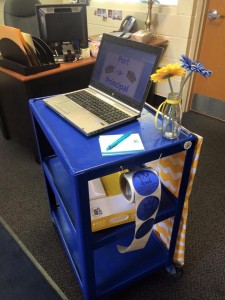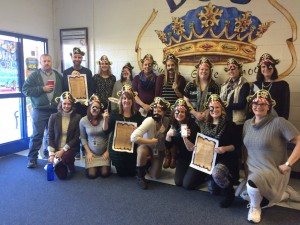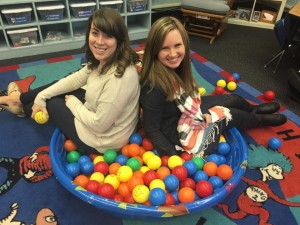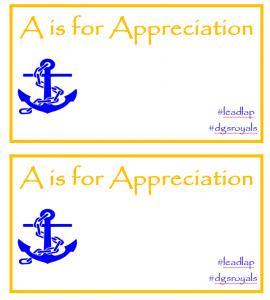Ten Things NOT to do as a Principal
10. Think you only have to wear a pant suit to work. Your staff and students expect you to remain professional at all times, but it is equally important to remember to have fun, take risks, and create memorable and meaningful working and learning environments. I find no shame in dressing up as a banana, hot dog, superhero, rock star, book character, or in other costumes if it means making an impact on my students.

9. Forget about the Parents: The parents of our students are our greatest allies and partners in education. Think outside the box in how you can you show appreciate and gratitude for parents or engage them in unique and meaningful learning opportunities!
https://dunlapgradeschool.edublogs.org/2015/10/06/dgs-literacy-harvest/
http://blogs.dunlapcusd.net/d323/2015/12/02/donut-drop-of-gratitude-at-dunlap-grade-school/
8. Lock Yourself in the Office: A key piece to my principalship has been my portable office. The Port-a-Principal is simple. I spray painted an old AV cart (that was on its way to the dumpster) in royal blue (of course). With a couple touches, it is now a mobile office that will allow me to stay connected to email and the school secretary while being visible in the hallways and classrooms. It is stocked with stickers, post-its and note cards that will allow me to leave notes of encouragement to staff and students, provide feedback on their work, and support their teaching and learning. With all the necessities of my office, I can observe lessons, engage with students, and still respond to emails or situations that need my attention in the office. I enjoy carting around the port-a-principal , and more importantly, interacting on a more frequent and regular basis with my students and staff.

7.Communicate in a Single Manner: Gone are the days of relying on paper newsletters as a sole strategy for communication in my building. Parents are provided with updates through digital newsletters, video updates, facebook posts, blogs, twitter, and Instagram posts. Promoting the positive elements of our school, including student learning and best teaching practices, plays an important part in establishing relationships, trust, and communication with parents, families and the community.
(https://dunlapgradeschool.edublogs.org/2016/01/15/promoting-positive-school-communication-with-video-updates/)
@dgsroyals
www.facebook.com/dunlapgrade
https://www.instagram.com/dgsroyals/
6. Forget about your Personal Inspirations: I often say that I want to be the leader and principal that I would want my daughters to have. They are the driving force that propels me to continue to learn, improve and grow in my leadership abilities and to seek new and innovative ways to teach and learn. I continuously learn from my own children and in doing so, develop and hone my leadership abilities. These reflections come at inopportune times, including times I relish as a mom at gymnastics practices! https://dunlapgradeschool.edublogs.org/2015/11/04/lessons-from-a-gymnast/
Furthermore, much of my inspiration and love of learning comes from watching my own two children grow and develop. I often employ strategies from my home at school and from school at home. My girls truly make me a better leader and I’d be remiss not to link my passion of education wtih my inspirations that come from being a mom: https://nerdybookclub.wordpress.com/2015/12/04/how-does-a-principal-foster-a-love-of-reading-in-her-own-children-by-mandy-ellis/
5. Think that Professional Development has to take the form of a Traditional Staff Meeting to be Effective: As a teacher, I sat through my share of institutes and faculty meetings that were laborious and tedious. The information was either not relevant to my position or could have been communicated through an e-mail. Professional Learning does not have to be that way. As educational leaders, we have to think creatively to model for our staff how learning can be engaging, differentiated, meaningful and FUN! I have done this in numerous ways:
https://dunlapgradeschool.edublogs.org/2015/12/08/the-ripple-effect-thinking-of-professional-learning-differently/

4. Fail to Provide Feedback to Staff: Our teachers are the front lines that make an impact on the success and achievement of our students and school. I participated (and continue to participate) in a series of challenges that have provided a structure for showing appreciation, honoring voice, and offering support for teachers. You can learn more on twitter at #leadlap or read my posts below:
https://dunlapgradeschool.edublogs.org/2015/10/20/a-is-for-appreciation-challenge-accepted/
https://dunlapgradeschool.edublogs.org/2015/11/12/challenge-accepted-honoring-voice-and-choice-in-teachers/
https://dunlapgradeschool.edublogs.org/2015/11/19/challenge-accepted-o-is-for-offer-support/
https://dunlapgradeschool.edublogs.org/2015/12/04/great-learning-comes-from-happy-teachers-happy-teachers-come-from-dgs/
3. Think Reading is ONLY for the Students: Anyone knows me, knows that I love to read. I firmly believe that leaders are readers and readers are leaders. I share my love of learning and reading in my building with displays of my current book titles, an update in my weekly staff memo with my current book titles, and a good reads account linked to my blog and webpage. I look forward to seeking and reading new titles, tweeting resources and sharing new practices and ideas with my staff (in memos, the lounge or even posted in the staff bathrooms!) My top ten books for professional reading can be seen at https://dunlapgradeschool.edublogs.org/2015/10/13/top-10-cornerstone-books-in-my-professional-library/
2.Ignore the Impacts that PIRATES can have on Teaching and Learning: Pirates? Really? “Teach Like a Pirate” was written by Dave Burgess and has been revolutionizing teaching and learning since its publication. This has been a game changer for my staff and me. The book details how to increase student engagement through various instructional hooks. TLAP reinforces the art of teaching as the cornerstone of education and focuses on the presentation of a lesson in congruence with content knowledge and curriculum. It is important to me that we set the stage for student learning in the environments and experiences we create. Why wouldn’t you roll out the red carpet for your students on the first day of school?

I was able to guest moderate a twitter TLAP chat on 10.05.2015 that you can read at https://dunlapgradeschool.edublogs.org/2015/10/06/teach-like-a-pirate-twitter-chat-10-05-2015/.
I also reflected on the opportunity to meet with and learn from Mr. Burgess at https://dunlapgradeschool.edublogs.org/2015/10/01/finding-the-spark-lighting-a-flame/
1. Take Yourself Seriously. You work for 5-12-year-old children. There is always a time to be professional, communicate effectively, and manage a building. Leading a building and staff is vital to success of an institution and cannot be overlooked, but when all is said and done, you are creating learning environments to promote lifelong readers, learners and thinkers. Kids need to feel important, empowered, and loved. Why not do that while having a little fun?


 As teachers or staff members sat in the ball pit, they pulled questions and prompted answers from their partners. Questions included light-hearted questions to get-to-know each other and education related topics focused on sharing strategies and best practices. Some questions included:
As teachers or staff members sat in the ball pit, they pulled questions and prompted answers from their partners. Questions included light-hearted questions to get-to-know each other and education related topics focused on sharing strategies and best practices. Some questions included:









